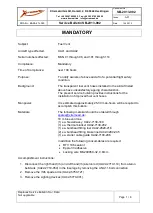
SOCATA
MODEL TB 20
SECTION 8
AIRPLANE HANDLING, SERVICING
AND MAINTENANCE
The content of this document is the property of
socata
. It is supplied in
confidence and commercial security of its contents must be maintained.
It must not be used for any purpose other than that for which it is supplied, nor
may information contained in it be disclosed to unauthorized persons. It must not
be reproduced nor transmitted in any form in whole or in part without permission
in writing from the owners of the Copyright.
Information in this document is subject to change without notice.
© 1988, 1991, 1992, 1994 to 1996, 1997, 2000 -
socata
- All rights reserved
June 30, 1988
Revision 5
8.10
Oil and oil filter change :
After the first 25 hours of operation, drain engine oil sump and replace filter.
Refill sump with straight mineral oil and use this kind of oil until a total of 50
hours has accumulated or oil consumption has stabilized ; then change to
dispersant oil and replace filter. It is recommended that the oil filter element
be changed every 50 hours or sooner under unfavourable conditions. Engine
oil is changed with the filter. Drain the engine oil sump and replace the filter at
least every 4 months even though less than the recommended hours have
accumulated. Reduce intervals for prolonged operation in dusty areas, cold
climates, or even when short flights and long idle periods result in sludging
conditions.
NOTE :
During the first 25–hour oil and filter change, a general inspection of engine
compartment is required. Items which are not normally checked during a
preflight inspection should be given a particular attention. Hoses, metal lines
and fittings should be inspected for signs of oil and fuel leaks, and checked for
abrasions, chafing, security, proper routing and support and evidence of
deterioration.
Inspect the intake and exhaust systems for cracks, evidence of leakage and
security of attachment. Engine controls and linkages should be checked for
freedom of movement through their full range, security of attachment and
evidence of wear. Inspect wirings for security, chafing, burning, defective
insulation, loose or broken terminals, heat deterioration and corroded
terminals. Check the alternator belt and retighten if necessary. A periodic
check of these items during subsequent servicing operations is
recommended.









































